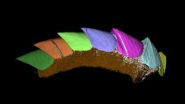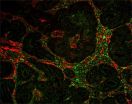(Press-News.org) Scientists have discovered a rare fossil called Kulindroplax, the missing link between two mollusc groups, which is revealed in a 3D computer model, in research published today in the journal Nature.
The researchers have unearthed the worm-like partly shelled Kulindroplax, which they have modelled in a 3D computer animation. Kulindroplax lived in the sea during the Silurian Period, approximately 425 million years ago, when most life lived in the oceans and the first plants were beginning to grow on land. The team found the Kulindroplax fossil, the only one of its kind in the world, in the Welsh borderland, and it is providing the evolutionary missing link between two groups of molluscs and shedding more light on the their early origins.
The study was led by Dr Mark Sutton, from the Department of Earth Science and Engineering at Imperial College London, in conjunction with researchers from the Universities of Oxford, Leicester, Yale and Queen's University Belfast.
Dr Sutton says: "Most people don't realise that molluscs, which have been around for hundreds of millions of years, are an extremely rich and diverse branch of life on Earth. Just as tracing a long lost uncle is important for developing a more complete family tree, unearthing this extremely rare and ancient Kulindroplax fossil is helping us to understand the relationship between two mollusc groups, which is also helping us to understand how molluscs have evolved on Earth."
VIDEO:
Scientists have discovered a rare fossil called Kulindroplax, the missing link between two mollusc groups, which is revealed in a 3D computer model, in research published today in the journalNature....
Click here for more information.
For over 20 years, scientists have debated the evolutionary relationship between two groups of molluscs called the aplacophorans, which are carnivorous, worm-like, sea-living creatures, and the chitons, which are molluscs that have shell plates for armour and live in the sea or on the seashore– both still live in Earth's oceans today.
The researchers in today's study analysed the 3D model of Kulindroplax and discovered that it had the worm-like body of the aplacophorans, but was partly shelled like the chitons. The combination of features in Kulindroplax confirmed to the team that that aplacophorans and chitons are closely related. Furthermore, the researchers believe that their 3D fossil is the missing link that shows how the worm-like aplacophorans evolved from chiton-like ancestors by losing their shells, providing fresh insight into the mollusc evolutionary tree.
The researchers discovered the Kulindroplax fossil, which is the size of a small caterpillar, in a deposit called the Herefordshire Lagerstätte. This deposit was formed when a cloud of volcanic ash settled through the Siluian seas and entombed a range of species, including Kulindroplax, as almost perfectly preserved fossils.
In order to develop their 3D animation, the team cut the Kulindroplax fossil into 1300 slices, taking digital images of each one, which were fed into a computer. The researchers in the study say this method provides unprecedented detail from the fossils, enabling them to analyse features that have been previously unseen.
INFORMATION:
Mollusc missing link revealed in 3-D
2012-10-04
ELSE PRESS RELEASES FROM THIS DATE:
Blocking tumor-induced inflammation impacts cancer development
2012-10-04
Researchers at the University of California, San Diego School of Medicine report the discovery of microbial–dependent mechanisms through which some cancers mount an inflammatory response that fuels their development and growth.
The findings are published in the October 3, 2012 Advanced Online Edition of Nature.
The association between chronic inflammation and tumor development has long been known from the early work of German pathologist Rudolph Virchow. Harvard University pathologist Harold Dvorak later compared tumors with "wounds that never heal," noting the similarities ...
Healthcare professionals as bad as patients at good respiratory inhaler technique
2012-10-04
Healthcare professionals are as bad as patients when it comes to knowing how to use inhalers prescribed for asthma and other respiratory conditions correctly, says an editorial in Drug and Therapeutics Bulletin (DTB).
They therefore can't be relied on to teach patients how to use these devices correctly, says DTB.
But as 45 million prescriptions for respiratory inhalers were dispensed in 2011 in England alone—at a cost of £900 million to the NHS—everyone needs to be more clued up on correct inhaler technique to make sure these drugs work well for patients and offer ...
Aspirin may temper brain power decline in elderly women at risk of heart disease
2012-10-04
Daily low dose aspirin could slow the decline in brain power among elderly women at high risk of heart disease, indicates observational research published in the online journal BMJ Open.
The researchers base their findings on 681 women between the ages of 70 and 92, 601 of whom were at high risk of heart disease and stroke, defined as a 10% or greater risk on a validated risk scale (Framingham).
All the women were subjected to a battery of tests to measure their physical health and intellectual capacity, including verbal fluency and memory speed, and dementia (mini ...
Ancient mollusk tells a contrary story
2012-10-04
New Haven, Conn. — A fossil unearthed in Great Britain may end a long-running debate about the mollusks, one of life's most diverse invertebrate groups: Which evolved first, shelled forms like clams and snails, or their shell-less, worm-like relatives?
The small new fossil, found in marine rocks along the English-Welsh border, provides the best fossil evidence yet that the simpler worm-like mollusks evolved from their more anatomically complex shelled brethren, rather than the other way around.
The discovery reinforces previous findings from molecular sequencing studies ...
Southern Hemisphere becoming drier
2012-10-04
A decline in April-May rainfall over south-east Australia is associated with a southward expansion of the subtropical dry-zone according to research published today in Scientific Reports, a primary research journal from the publishers of Nature.
CSIRO scientists Wenju Cai, Tim Cowan and Marcus Thatcher explored why autumn rainfall has been in decline across south-eastern Australia since the 1970s, a period that included the devastating Millennium drought from 1997-2009.
Previous research into what has been driving the decline in autumn rainfall across regions like southern ...
Black hole surprise in ancient star cluster
2012-10-04
Astronomers have made the unexpected discovery of two black holes inside an ancient cluster of stars in our galaxy, the Milky Way.
The research, published today in the prestigious journal Nature, describes the detection of two black holes that are about 10 to 20 times heavier than our Sun in the globular cluster named M22.
Black holes, so dense that even light can't escape them, are what is left when a massive star reaches the end of its life and collapses in on itself.
Co-author Dr James Miller-Jones, from the Curtin University node of the International Centre for ...
Researchers identify dozens of new de novo genetic mutations in schizophrenia
2012-10-04
New York, NY (October 3, 2012) — Columbia University Medical Center (CUMC) researchers have identified dozens of new spontaneous genetic mutations that play a significant role in the development of schizophrenia, adding to the growing list of genetic variants that can contribute to the disease. The study, the largest and most comprehensive of its kind, was published today in the online edition of the journal Nature Genetics.
Although schizophrenia typically onsets during adolescence and early adulthood, many of the mutations were found to affect genes with higher expression ...
UT Dallas research shows graphene nanopores can be controlled
2012-10-04
Engineers at The University of Texas at Dallas have used advanced techniques to make the material graphene small enough to read DNA.
Shrinking the size of a graphene pore to less than one nanometer – small enough to thread a DNA strand – opens the possibility of using graphene as a low-cost tool to sequence DNA.
"Sequencing DNA at a very cheap cost would enable scientists and doctors to better predict and diagnose disease, and also tailor a drug to an individual's genetic code," said Dr. Moon Kim, professor of materials science and engineering. He was senior author ...
Tomb of Maya queen K'abel discovered in Guatemala
2012-10-04
Archaeologists in Guatemala have discovered the tomb of Lady K'abel, a seventh-century Maya Holy Snake Lord considered one of the great queens of Classic Maya civilization.
The tomb was discovered during excavations of the royal Maya city of El Perú-Waka' in northwestern Petén, Guatemala, by a team of archaeologists led by Washington University in St. Louis' David Freidel, co-director of the expedition.
Along with David Freidel, professor of anthropology at WUSTL, the project is co-directed by Juan Carlos Pérez, former vice minister of culture for cultural heritage of ...
Getting athletes back in the game sooner following shoulder injuries
2012-10-04
Athletics have always been a part of Jade Dismore's life. The 27-year-old native of South Africa grew up playing tennis and swimming; as an adult she became an avid runner and recreational volleyball player. For several years she felt soreness in her shoulder, but assumed it was nothing serious. As she began training for her first triathlon, the pain became increasingly severe. After trying to manage the pain on her own for years, Dismore decided it was time to seek medical attention.
"I started feeling dull pain in my shoulder about four or five years ago and tried ...

